CloudFormation - Creating an ASG with rolling update
In this page, we'll create an Auto Scaling group with an update policy that keeps 2 instances running during a rolling update using CloudFormation.
To specify how AWS CloudFormation handles rolling updates for an Auto Scaling group, we use the AutoScalingRollingUpdate Policy.
Rolling updates enable us to specify whether AWS CloudFormation updates instances that are in an Auto Scaling group in batches or all at once.
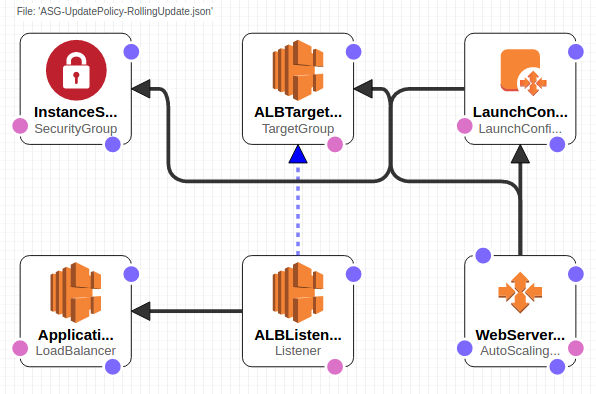
Here is the snippet of the AutoScalingRollingUpdate:
...
"Resources": {
...
},
"UpdatePolicy" : {
"AutoScalingRollingUpdate" : {
"MaxBatchSize" : "1",
"MinInstancesInService" : "1",
"PauseTime" : "PT15M",
"WaitOnResourceSignals": "true"
}
},
...
},
...
- MaxBatchSize - Specifies the maximum number of instances that AWS CloudFormation updates.
- MinInstancesInService - Specifies the minimum number of instances that must be in service within the Auto Scaling group while AWS CloudFormation updates old instances.
- PauseTime - The amount of time that AWS CloudFormation pauses after making a change to a batch of instances to give those instances time to start software applications.
If we enable the WaitOnResourceSignals property, PauseTime is the amount of time that AWS CloudFormation should wait for the Auto Scaling group to receive the required number of valid signals from added or replaced instances. If the PauseTime is exceeded before the Auto Scaling group receives the required number of signals, the update fails. For best results, specify a time period that gives our applications sufficient time to get started. If the update needs to be rolled back, a short PauseTime can cause the rollback to fail.
Specify PauseTime in the ISO8601 duration format (in the format PT#H#M#S, where each # is the number of hours, minutes, and seconds, respectively). The maximum PauseTime is one hour (PT1H). We used 15 min. - WaitOnResourceSignals - Specifies whether the Auto Scaling group waits on signals from new instances during an update. We use this property to ensure that instances have completed installing and configuring applications before the Auto Scaling group update proceeds. AWS CloudFormation suspends the update of an Auto Scaling group after new EC2 instances are launched into the group. AWS CloudFormation must receive a signal from each new instance within the specified PauseTime before continuing the update. To signal the Auto Scaling group, use the cfn-signal helper script or SignalResource API.
Here is our full template:
{
"AWSTemplateFormatVersion": "2010-09-09",
"Description": "AWS CloudFormation Sample Template AutoScalingRollingUpdates: Create a load balanced, Auto Scaled sample website. This example creates an Auto Scaling group behind a load balancer with a simple health check. The AutoScaling launch configuration includes an update policy that will keep 2 instances running while doing an autoscaling rolling upgrade. **WARNING** This template creates one or more Amazon EC2 instances and an Application Load Balancer. You will be billed for the AWS resources used if you create a stack from this template.",
"Parameters": {
"VpcId" : {
"Type" : "AWS::EC2::VPC::Id",
"Description" : "VpcId of your existing Virtual Private Cloud (VPC)",
"ConstraintDescription" : "must be the VPC Id of an existing Virtual Private Cloud."
},
"Subnets" : {
"Type" : "List<AWS::EC2::Subnet::Id>",
"Description" : "The list of SubnetIds in your Virtual Private Cloud (VPC)",
"ConstraintDescription" : "must be a list of at least two existing subnets associated with at least two different availability zones. They should be residing in the selected Virtual Private Cloud."
},
"InstanceType": {
"Description": "WebServer EC2 instance type",
"Type": "String",
"Default": "t2.nano",
"AllowedValues": [ "t1.micro", "t2.nano", "t2.micro", "t2.small", "t2.medium", "t2.large", "m1.small", "m1.medium", "m1.large", "m1.xlarge", "m2.xlarge", "m2.2xlarge", "m2.4xlarge", "m3.medium", "m3.large", "m3.xlarge", "m3.2xlarge", "m4.large", "m4.xlarge", "m4.2xlarge", "m4.4xlarge", "m4.10xlarge", "c1.medium", "c1.xlarge", "c3.large", "c3.xlarge", "c3.2xlarge", "c3.4xlarge", "c3.8xlarge", "c4.large", "c4.xlarge", "c4.2xlarge", "c4.4xlarge", "c4.8xlarge", "g2.2xlarge", "g2.8xlarge", "r3.large", "r3.xlarge", "r3.2xlarge", "r3.4xlarge", "r3.8xlarge", "i2.xlarge", "i2.2xlarge", "i2.4xlarge", "i2.8xlarge", "d2.xlarge", "d2.2xlarge", "d2.4xlarge", "d2.8xlarge", "hi1.4xlarge", "hs1.8xlarge", "cr1.8xlarge", "cc2.8xlarge", "cg1.4xlarge"]
,
"ConstraintDescription": "must be a valid EC2 instance type."
},
"KeyName": {
"Description": "Name of an existing EC2 KeyPair to enable SSH access to the instances",
"Type": "AWS::EC2::KeyPair::KeyName",
"ConstraintDescription" : "must be the name of an existing EC2 KeyPair."
},
"SSHLocation" : {
"Description" : "The IP address range that can be used to SSH to the EC2 instances",
"Type": "String",
"MinLength": "9",
"MaxLength": "18",
"Default": "0.0.0.0/0",
"AllowedPattern": "(\\d{1,3})\\.(\\d{1,3})\\.(\\d{1,3})\\.(\\d{1,3})/(\\d{1,2})",
"ConstraintDescription": "must be a valid IP CIDR range of the form x.x.x.x/x."
}
},
"Mappings": {
"Region2Examples" : {
"us-east-1" : { "Examples" : "https://s3.amazonaws.com/cloudformation-examples-us-east-1" },
"us-west-2" : { "Examples" : "https://s3-us-west-2.amazonaws.com/cloudformation-examples-us-west-2" },
"us-west-1" : { "Examples" : "https://s3-us-west-1.amazonaws.com/cloudformation-examples-us-west-1" },
"eu-west-1" : { "Examples" : "https://s3-eu-west-1.amazonaws.com/cloudformation-examples-eu-west-1" },
"eu-west-2" : { "Examples" : "https://s3-eu-west-2.amazonaws.com/cloudformation-examples-eu-west-2" },
"eu-central-1" : { "Examples" : "https://s3-eu-central-1.amazonaws.com/cloudformation-examples-eu-central-1" },
"ap-southeast-1" : { "Examples" : "https://s3-ap-southeast-1.amazonaws.com/cloudformation-examples-ap-southeast-1" },
"ap-northeast-1" : { "Examples" : "https://s3-ap-northeast-1.amazonaws.com/cloudformation-examples-ap-northeast-1" },
"ap-northeast-2" : { "Examples" : "https://s3-ap-northeast-2.amazonaws.com/cloudformation-examples-ap-northeast-2" },
"ap-southeast-2" : { "Examples" : "https://s3-ap-southeast-2.amazonaws.com/cloudformation-examples-ap-southeast-2" },
"ap-south-1" : { "Examples" : "https://s3-ap-south-1.amazonaws.com/cloudformation-examples-ap-south-1" },
"us-east-2" : { "Examples" : "https://s3-us-east-2.amazonaws.com/cloudformation-examples-us-east-2" },
"ca-central-1" : { "Examples" : "https://s3-ca-central-1.amazonaws.com/cloudformation-examples-ca-central-1" },
"sa-east-1" : { "Examples" : "https://s3-sa-east-1.amazonaws.com/cloudformation-examples-sa-east-1" },
"cn-north-1" : { "Examples" : "https://s3.cn-north-1.amazonaws.com.cn/cloudformation-examples-cn-north-1" }
}
,
"AWSInstanceType2Arch" : {
"t1.micro" : { "Arch" : "PV64" },
"t2.nano" : { "Arch" : "HVM64" },
"t2.micro" : { "Arch" : "HVM64" },
"t2.small" : { "Arch" : "HVM64" },
"t2.medium" : { "Arch" : "HVM64" },
"t2.large" : { "Arch" : "HVM64" },
"m1.small" : { "Arch" : "PV64" },
"m1.medium" : { "Arch" : "PV64" },
"m1.large" : { "Arch" : "PV64" },
"m1.xlarge" : { "Arch" : "PV64" },
"m2.xlarge" : { "Arch" : "PV64" },
"m2.2xlarge" : { "Arch" : "PV64" },
"m2.4xlarge" : { "Arch" : "PV64" },
"m3.medium" : { "Arch" : "HVM64" },
"m3.large" : { "Arch" : "HVM64" },
"m3.xlarge" : { "Arch" : "HVM64" },
"m3.2xlarge" : { "Arch" : "HVM64" },
"m4.large" : { "Arch" : "HVM64" },
"m4.xlarge" : { "Arch" : "HVM64" },
"m4.2xlarge" : { "Arch" : "HVM64" },
"m4.4xlarge" : { "Arch" : "HVM64" },
"m4.10xlarge" : { "Arch" : "HVM64" },
"c1.medium" : { "Arch" : "PV64" },
"c1.xlarge" : { "Arch" : "PV64" },
"c3.large" : { "Arch" : "HVM64" },
"c3.xlarge" : { "Arch" : "HVM64" },
"c3.2xlarge" : { "Arch" : "HVM64" },
"c3.4xlarge" : { "Arch" : "HVM64" },
"c3.8xlarge" : { "Arch" : "HVM64" },
"c4.large" : { "Arch" : "HVM64" },
"c4.xlarge" : { "Arch" : "HVM64" },
"c4.2xlarge" : { "Arch" : "HVM64" },
"c4.4xlarge" : { "Arch" : "HVM64" },
"c4.8xlarge" : { "Arch" : "HVM64" },
"g2.2xlarge" : { "Arch" : "HVMG2" },
"g2.8xlarge" : { "Arch" : "HVMG2" },
"r3.large" : { "Arch" : "HVM64" },
"r3.xlarge" : { "Arch" : "HVM64" },
"r3.2xlarge" : { "Arch" : "HVM64" },
"r3.4xlarge" : { "Arch" : "HVM64" },
"r3.8xlarge" : { "Arch" : "HVM64" },
"i2.xlarge" : { "Arch" : "HVM64" },
"i2.2xlarge" : { "Arch" : "HVM64" },
"i2.4xlarge" : { "Arch" : "HVM64" },
"i2.8xlarge" : { "Arch" : "HVM64" },
"d2.xlarge" : { "Arch" : "HVM64" },
"d2.2xlarge" : { "Arch" : "HVM64" },
"d2.4xlarge" : { "Arch" : "HVM64" },
"d2.8xlarge" : { "Arch" : "HVM64" },
"hi1.4xlarge" : { "Arch" : "HVM64" },
"hs1.8xlarge" : { "Arch" : "HVM64" },
"cr1.8xlarge" : { "Arch" : "HVM64" },
"cc2.8xlarge" : { "Arch" : "HVM64" }
},
"AWSInstanceType2NATArch" : {
"t1.micro" : { "Arch" : "NATPV64" },
"t2.nano" : { "Arch" : "NATHVM64" },
"t2.micro" : { "Arch" : "NATHVM64" },
"t2.small" : { "Arch" : "NATHVM64" },
"t2.medium" : { "Arch" : "NATHVM64" },
"t2.large" : { "Arch" : "NATHVM64" },
"m1.small" : { "Arch" : "NATPV64" },
"m1.medium" : { "Arch" : "NATPV64" },
"m1.large" : { "Arch" : "NATPV64" },
"m1.xlarge" : { "Arch" : "NATPV64" },
"m2.xlarge" : { "Arch" : "NATPV64" },
"m2.2xlarge" : { "Arch" : "NATPV64" },
"m2.4xlarge" : { "Arch" : "NATPV64" },
"m3.medium" : { "Arch" : "NATHVM64" },
"m3.large" : { "Arch" : "NATHVM64" },
"m3.xlarge" : { "Arch" : "NATHVM64" },
"m3.2xlarge" : { "Arch" : "NATHVM64" },
"m4.large" : { "Arch" : "NATHVM64" },
"m4.xlarge" : { "Arch" : "NATHVM64" },
"m4.2xlarge" : { "Arch" : "NATHVM64" },
"m4.4xlarge" : { "Arch" : "NATHVM64" },
"m4.10xlarge" : { "Arch" : "NATHVM64" },
"c1.medium" : { "Arch" : "NATPV64" },
"c1.xlarge" : { "Arch" : "NATPV64" },
"c3.large" : { "Arch" : "NATHVM64" },
"c3.xlarge" : { "Arch" : "NATHVM64" },
"c3.2xlarge" : { "Arch" : "NATHVM64" },
"c3.4xlarge" : { "Arch" : "NATHVM64" },
"c3.8xlarge" : { "Arch" : "NATHVM64" },
"c4.large" : { "Arch" : "NATHVM64" },
"c4.xlarge" : { "Arch" : "NATHVM64" },
"c4.2xlarge" : { "Arch" : "NATHVM64" },
"c4.4xlarge" : { "Arch" : "NATHVM64" },
"c4.8xlarge" : { "Arch" : "NATHVM64" },
"g2.2xlarge" : { "Arch" : "NATHVMG2" },
"g2.8xlarge" : { "Arch" : "NATHVMG2" },
"r3.large" : { "Arch" : "NATHVM64" },
"r3.xlarge" : { "Arch" : "NATHVM64" },
"r3.2xlarge" : { "Arch" : "NATHVM64" },
"r3.4xlarge" : { "Arch" : "NATHVM64" },
"r3.8xlarge" : { "Arch" : "NATHVM64" },
"i2.xlarge" : { "Arch" : "NATHVM64" },
"i2.2xlarge" : { "Arch" : "NATHVM64" },
"i2.4xlarge" : { "Arch" : "NATHVM64" },
"i2.8xlarge" : { "Arch" : "NATHVM64" },
"d2.xlarge" : { "Arch" : "NATHVM64" },
"d2.2xlarge" : { "Arch" : "NATHVM64" },
"d2.4xlarge" : { "Arch" : "NATHVM64" },
"d2.8xlarge" : { "Arch" : "NATHVM64" },
"hi1.4xlarge" : { "Arch" : "NATHVM64" },
"hs1.8xlarge" : { "Arch" : "NATHVM64" },
"cr1.8xlarge" : { "Arch" : "NATHVM64" },
"cc2.8xlarge" : { "Arch" : "NATHVM64" }
}
,
"AWSRegionArch2AMI" : {
"us-east-1" : {"PV64" : "ami-2a69aa47", "HVM64" : "ami-6869aa05", "HVMG2" : "ami-61e27177"},
"us-west-2" : {"PV64" : "ami-7f77b31f", "HVM64" : "ami-7172b611", "HVMG2" : "ami-60aa3700"},
"us-west-1" : {"PV64" : "ami-a2490dc2", "HVM64" : "ami-31490d51", "HVMG2" : "ami-4b694d2b"},
"eu-west-1" : {"PV64" : "ami-4cdd453f", "HVM64" : "ami-f9dd458a", "HVMG2" : "ami-2955524f"},
"eu-west-2" : {"PV64" : "NOT_SUPPORTED", "HVM64" : "ami-886369ec", "HVMG2" : "NOT_SUPPORTED"},
"eu-central-1" : {"PV64" : "ami-6527cf0a", "HVM64" : "ami-ea26ce85", "HVMG2" : "ami-81ac71ee"},
"ap-northeast-1" : {"PV64" : "ami-3e42b65f", "HVM64" : "ami-374db956", "HVMG2" : "ami-46220c21"},
"ap-northeast-2" : {"PV64" : "NOT_SUPPORTED", "HVM64" : "ami-2b408b45", "HVMG2" : "NOT_SUPPORTED"},
"ap-southeast-1" : {"PV64" : "ami-df9e4cbc", "HVM64" : "ami-a59b49c6", "HVMG2" : "ami-c212aba1"},
"ap-southeast-2" : {"PV64" : "ami-63351d00", "HVM64" : "ami-dc361ebf", "HVMG2" : "ami-0ad2db69"},
"ap-south-1" : {"PV64" : "NOT_SUPPORTED", "HVM64" : "ami-ffbdd790", "HVMG2" : "ami-ca3042a5"},
"us-east-2" : {"PV64" : "NOT_SUPPORTED", "HVM64" : "ami-f6035893", "HVMG2" : "NOT_SUPPORTED"},
"ca-central-1" : {"PV64" : "NOT_SUPPORTED", "HVM64" : "ami-730ebd17", "HVMG2" : "NOT_SUPPORTED"},
"sa-east-1" : {"PV64" : "ami-1ad34676", "HVM64" : "ami-6dd04501", "HVMG2" : "NOT_SUPPORTED"},
"cn-north-1" : {"PV64" : "ami-77559f1a", "HVM64" : "ami-8e6aa0e3", "HVMG2" : "NOT_SUPPORTED"}
}
},
"Resources": {
"WebServerGroup": {
"Type": "AWS::AutoScaling::AutoScalingGroup",
"CreationPolicy" : {
"ResourceSignal" : {
"Timeout" : "PT15M",
"Count" : "2"
}
},
"UpdatePolicy" : {
"AutoScalingRollingUpdate" : {
"MaxBatchSize" : "1",
"MinInstancesInService" : "1",
"PauseTime" : "PT15M",
"WaitOnResourceSignals": "true"
}
},
"Properties": {
"VPCZoneIdentifier" : { "Ref" : "Subnets" },
"LaunchConfigurationName": { "Ref": "LaunchConfig" },
"MinSize": "2",
"MaxSize": "4",
"TargetGroupARNs": [ { "Ref": "ALBTargetGroup" } ]
}
},
"LaunchConfig": {
"Type": "AWS::AutoScaling::LaunchConfiguration",
"Metadata" : {
"Comment" : "Install a simple application",
"AWS::CloudFormation::Init" : {
"config" : {
"packages" : {
"yum" : {
"httpd" : []
}
},
"files" : {
"/var/www/html/index.html" : {
"content" : { "Fn::Join" : ["\n", [
"<img src=\"", {"Fn::FindInMap" : ["Region2Examples", {"Ref" : "AWS::Region"}, "Examples"]}, "/cloudformation_graphic.png\" alt=\"AWS CloudFormation Logo\"/>",
"<h1>Congratulations, you have successfully launched the AWS CloudFormation sample.</h1>"
]]},
"mode" : "000644",
"owner" : "root",
"group" : "root"
},
"/etc/cfn/cfn-hup.conf" : {
"content" : { "Fn::Join" : ["", [
"[main]\n",
"stack=", { "Ref" : "AWS::StackId" }, "\n",
"region=", { "Ref" : "AWS::Region" }, "\n"
]]},
"mode" : "000400",
"owner" : "root",
"group" : "root"
},
"/etc/cfn/hooks.d/cfn-auto-reloader.conf" : {
"content": { "Fn::Join" : ["", [
"[cfn-auto-reloader-hook]\n",
"triggers=post.update\n",
"path=Resources.LaunchConfig.Metadata.AWS::CloudFormation::Init\n",
"action=/opt/aws/bin/cfn-init -v ",
" --stack ", { "Ref" : "AWS::StackName" },
" --resource LaunchConfig ",
" --region ", { "Ref" : "AWS::Region" }, "\n",
"runas=root\n"
]]}
}
},
"services" : {
"sysvinit" : {
"httpd" : { "enabled" : "true", "ensureRunning" : "true" },
"cfn-hup" : { "enabled" : "true", "ensureRunning" : "true",
"files" : ["/etc/cfn/cfn-hup.conf", "/etc/cfn/hooks.d/cfn-auto-reloader.conf"]}
}
}
}
}
},
"Properties": {
"KeyName": { "Ref": "KeyName" },
"ImageId": {
"Fn::FindInMap": [ "AWSRegionArch2AMI", { "Ref": "AWS::Region" },
{ "Fn::FindInMap": [ "AWSInstanceType2Arch", { "Ref": "InstanceType" }, "Arch" ] } ]
},
"SecurityGroups": [ { "Ref": "InstanceSecurityGroup" } ],
"InstanceType": { "Ref": "InstanceType" },
"UserData" : { "Fn::Base64" : { "Fn::Join" : ["", [
"#!/bin/bash -xe\n",
"yum update -y aws-cfn-bootstrap\n",
"/opt/aws/bin/cfn-init -v ",
" --stack ", { "Ref" : "AWS::StackName" },
" --resource LaunchConfig ",
" --region ", { "Ref" : "AWS::Region" }, "\n",
"/opt/aws/bin/cfn-signal -e $? ",
" --stack ", { "Ref" : "AWS::StackName" },
" --resource WebServerGroup ",
" --region ", { "Ref" : "AWS::Region" }, "\n"
]]}}
}
},
"ApplicationLoadBalancer" : {
"Type" : "AWS::ElasticLoadBalancingV2::LoadBalancer",
"Properties" : {
"Subnets" : { "Ref" : "Subnets"}
}
},
"ALBListener" : {
"Type" : "AWS::ElasticLoadBalancingV2::Listener",
"Properties" : {
"DefaultActions" : [{
"Type" : "forward",
"TargetGroupArn" : { "Ref" : "ALBTargetGroup" }
}],
"LoadBalancerArn" : { "Ref" : "ApplicationLoadBalancer" },
"Port" : "80",
"Protocol" : "HTTP"
}
},
"ALBTargetGroup" : {
"Type" : "AWS::ElasticLoadBalancingV2::TargetGroup",
"Properties" : {
"HealthCheckIntervalSeconds" : 30,
"HealthCheckTimeoutSeconds" : 5,
"HealthyThresholdCount" : 3,
"Port" : 80,
"Protocol" : "HTTP",
"UnhealthyThresholdCount" : 5,
"VpcId" : {"Ref" : "VpcId"}
}
},
"InstanceSecurityGroup": {
"Type": "AWS::EC2::SecurityGroup",
"Properties": {
"GroupDescription": "Enable SSH access and HTTP access on the configured port",
"SecurityGroupIngress": [
{ "IpProtocol": "tcp", "FromPort": "22", "ToPort": "22", "CidrIp": { "Ref" : "SSHLocation" } },
{ "IpProtocol": "tcp", "FromPort": "80", "ToPort": "80", "CidrIp": "0.0.0.0/0" }
],
"VpcId" : { "Ref" : "VpcId" }
}
}
},
"Outputs": {
"URL": {
"Description": "URL of the website",
"Value": { "Fn::Join": [ "", [ "http://", { "Fn::GetAtt": [ "ApplicationLoadBalancer", "DNSName" ] } ] ] }
}
}
}
Let's upload the template onto S3:
$ aws s3 cp ASG-UpdatePolicy-RollingUpdate.json s3://bogo-aws/alb/ASG-UpdatePolicy-RollingUpdate.json upload: ./ASG-UpdatePolicy-RollingUpdate.json to s3://bogo-aws/alb/ASG-UpdatePolicy-RollingUpdate.json
Then, create a stack:
$ aws cloudformation create-stack --stack-name my-rolling-update-alb-stack \ --template-url https://s3.amazonaws.com/bogo-aws/alb/ASG-UpdatePolicy-RollingUpdate.json \ --parameters ParameterKey=KeyName,ParameterValue=einsteinish ParameterKey=VpcId,ParameterValue=vpc-4c600529 \ ParameterKey=Subnets,ParameterValue=subnet-cef59af4\\,subnet-3114b568 --capabilities CAPABILITY_IAM arn:aws:cloudformation:us-east-1:526262051452:stack/my-rolling-update-alb-stack/aa9489a0-3dac-11e7-8d7f-50fae988d8d2

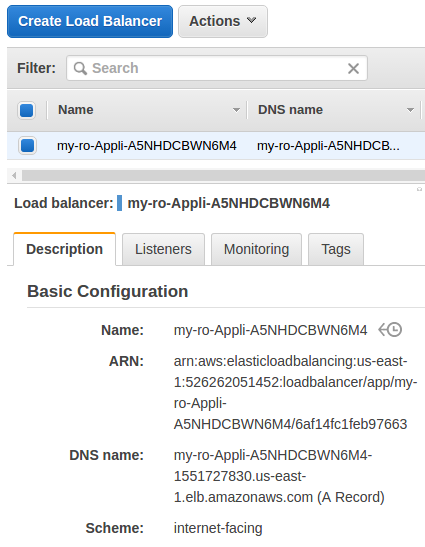
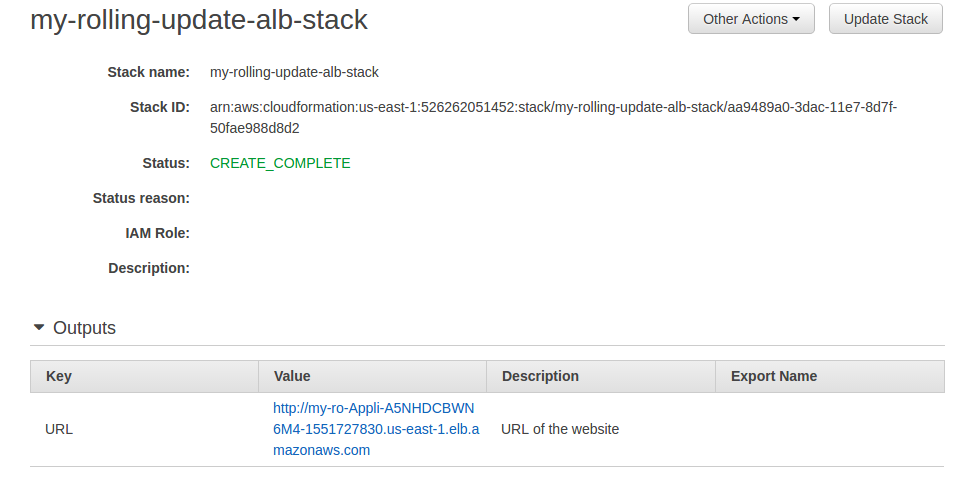
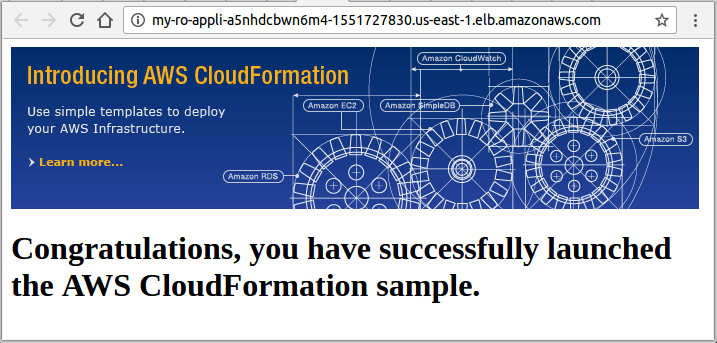
We'll use aws cloudformation update-stack command to directly update a stack.
Let's modify our index file:
... Congratulations, you have successfully launched the AWS CloudFormation sample v.2 ...
Then, update the stack:
$ aws cloudformation update-stack --stack-name my-rolling-update-alb-stack \ --template-url https://s3.amazonaws.com/bogo-aws/alb/ASG-UpdatePolicy-RollingUpdate.json \ --parameters ParameterKey=KeyName,ParameterValue=einsteinish ParameterKey=VpcId,ParameterValue=vpc-4c600529 \ ParameterKey=Subnets,ParameterValue=subnet-cef59af4\\,subnet-3114b568 --capabilities CAPABILITY_IAM arn:aws:cloudformation:us-east-1:526262051452:stack/my-rolling-update-alb-stack/aa9489a0-3dac-11e7-8d7f-50fae988d8d2
We can delete the stack using aws cloudformation delete-stack command:
$ aws cloudformation delete-stack --stack-name my-rolling-update-alb-stack
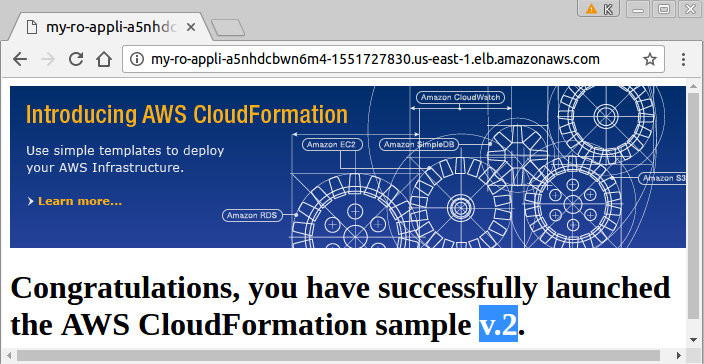
AWS (Amazon Web Services)
- AWS : EKS (Elastic Container Service for Kubernetes)
- AWS : Creating a snapshot (cloning an image)
- AWS : Attaching Amazon EBS volume to an instance
- AWS : Adding swap space to an attached volume via mkswap and swapon
- AWS : Creating an EC2 instance and attaching Amazon EBS volume to the instance using Python boto module with User data
- AWS : Creating an instance to a new region by copying an AMI
- AWS : S3 (Simple Storage Service) 1
- AWS : S3 (Simple Storage Service) 2 - Creating and Deleting a Bucket
- AWS : S3 (Simple Storage Service) 3 - Bucket Versioning
- AWS : S3 (Simple Storage Service) 4 - Uploading a large file
- AWS : S3 (Simple Storage Service) 5 - Uploading folders/files recursively
- AWS : S3 (Simple Storage Service) 6 - Bucket Policy for File/Folder View/Download
- AWS : S3 (Simple Storage Service) 7 - How to Copy or Move Objects from one region to another
- AWS : S3 (Simple Storage Service) 8 - Archiving S3 Data to Glacier
- AWS : Creating a CloudFront distribution with an Amazon S3 origin
- AWS : Creating VPC with CloudFormation
- AWS : WAF (Web Application Firewall) with preconfigured CloudFormation template and Web ACL for CloudFront distribution
- AWS : CloudWatch & Logs with Lambda Function / S3
- AWS : Lambda Serverless Computing with EC2, CloudWatch Alarm, SNS
- AWS : Lambda and SNS - cross account
- AWS : CLI (Command Line Interface)
- AWS : CLI (ECS with ALB & autoscaling)
- AWS : ECS with cloudformation and json task definition
- AWS Application Load Balancer (ALB) and ECS with Flask app
- AWS : Load Balancing with HAProxy (High Availability Proxy)
- AWS : VirtualBox on EC2
- AWS : NTP setup on EC2
- AWS: jq with AWS
- AWS & OpenSSL : Creating / Installing a Server SSL Certificate
- AWS : OpenVPN Access Server 2 Install
- AWS : VPC (Virtual Private Cloud) 1 - netmask, subnets, default gateway, and CIDR
- AWS : VPC (Virtual Private Cloud) 2 - VPC Wizard
- AWS : VPC (Virtual Private Cloud) 3 - VPC Wizard with NAT
- DevOps / Sys Admin Q & A (VI) - AWS VPC setup (public/private subnets with NAT)
- AWS - OpenVPN Protocols : PPTP, L2TP/IPsec, and OpenVPN
- AWS : Autoscaling group (ASG)
- AWS : Setting up Autoscaling Alarms and Notifications via CLI and Cloudformation
- AWS : Adding a SSH User Account on Linux Instance
- AWS : Windows Servers - Remote Desktop Connections using RDP
- AWS : Scheduled stopping and starting an instance - python & cron
- AWS : Detecting stopped instance and sending an alert email using Mandrill smtp
- AWS : Elastic Beanstalk with NodeJS
- AWS : Elastic Beanstalk Inplace/Rolling Blue/Green Deploy
- AWS : Identity and Access Management (IAM) Roles for Amazon EC2
- AWS : Identity and Access Management (IAM) Policies, sts AssumeRole, and delegate access across AWS accounts
- AWS : Identity and Access Management (IAM) sts assume role via aws cli2
- AWS : Creating IAM Roles and associating them with EC2 Instances in CloudFormation
- AWS Identity and Access Management (IAM) Roles, SSO(Single Sign On), SAML(Security Assertion Markup Language), IdP(identity provider), STS(Security Token Service), and ADFS(Active Directory Federation Services)
- AWS : Amazon Route 53
- AWS : Amazon Route 53 - DNS (Domain Name Server) setup
- AWS : Amazon Route 53 - subdomain setup and virtual host on Nginx
- AWS Amazon Route 53 : Private Hosted Zone
- AWS : SNS (Simple Notification Service) example with ELB and CloudWatch
- AWS : Lambda with AWS CloudTrail
- AWS : SQS (Simple Queue Service) with NodeJS and AWS SDK
- AWS : Redshift data warehouse
- AWS : CloudFormation
- AWS : CloudFormation Bootstrap UserData/Metadata
- AWS : CloudFormation - Creating an ASG with rolling update
- AWS : Cloudformation Cross-stack reference
- AWS : OpsWorks
- AWS : Network Load Balancer (NLB) with Autoscaling group (ASG)
- AWS CodeDeploy : Deploy an Application from GitHub
- AWS EC2 Container Service (ECS)
- AWS EC2 Container Service (ECS) II
- AWS Hello World Lambda Function
- AWS Lambda Function Q & A
- AWS Node.js Lambda Function & API Gateway
- AWS API Gateway endpoint invoking Lambda function
- AWS API Gateway invoking Lambda function with Terraform
- AWS API Gateway invoking Lambda function with Terraform - Lambda Container
- Amazon Kinesis Streams
- AWS: Kinesis Data Firehose with Lambda and ElasticSearch
- Amazon DynamoDB
- Amazon DynamoDB with Lambda and CloudWatch
- Loading DynamoDB stream to AWS Elasticsearch service with Lambda
- Amazon ML (Machine Learning)
- Simple Systems Manager (SSM)
- AWS : RDS Connecting to a DB Instance Running the SQL Server Database Engine
- AWS : RDS Importing and Exporting SQL Server Data
- AWS : RDS PostgreSQL & pgAdmin III
- AWS : RDS PostgreSQL 2 - Creating/Deleting a Table
- AWS : MySQL Replication : Master-slave
- AWS : MySQL backup & restore
- AWS RDS : Cross-Region Read Replicas for MySQL and Snapshots for PostgreSQL
- AWS : Restoring Postgres on EC2 instance from S3 backup
- AWS : Q & A
- AWS : Security
- AWS : Security groups vs. network ACLs
- AWS : Scaling-Up
- AWS : Networking
- AWS : Single Sign-on (SSO) with Okta
- AWS : JIT (Just-in-Time) with Okta
Ph.D. / Golden Gate Ave, San Francisco / Seoul National Univ / Carnegie Mellon / UC Berkeley / DevOps / Deep Learning / Visualization